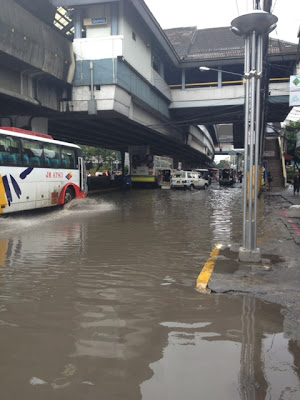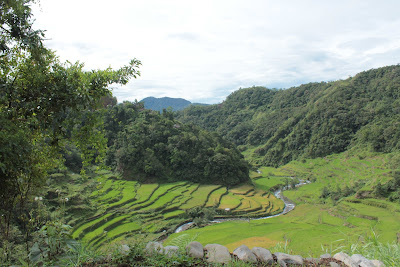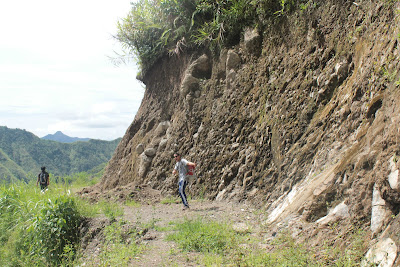The Philippines. A country of seven-thousand islands, mangos, and smiling happy-go-lucky people.
My boyfriend and I spent 2-weeks travelling throughout the Philippines.
This is part one.
Manila.
Everyone who has been said to skip this city, especially during rainy season. Seeing how we had no choice but to spend a day here, we wanted to prove them wrong. There had to be something worthy.
Well, guess what? They were right.
Life Lesson #1: skip Manila.
It rains.
It floods.
It's rather dirty.
At least the Catholic church was beautiful.
 |
| St. Augustine is known for being the oldest church in the Philippines. |
Did I mention it rains a lot?
So, Manila was not a success. It was the only time I felt a bit weary of my safety, the only time I had to sidestep human feces on the sidewalk, the only time I watched security guards scan crowds while holding shotguns, and only the first of two times I thought, "I hope this vacation gets better".
The reason we ventured through Manila for a day was to take a night bus to Banaue, a small city north of Manila known for their rice terraces and trekking. At the bus station we ask for tickets to Banaue. No, there's no bus to Banaue. You must go to Baguio and from there take a bus to Banaue.
Of course. Silly us.
We purchase two tickets to Baguio and endure more waiting and more rain until our 11pm bus left.
At midnight, as I'm cradled into a ball, shivering into Diego's shoulder, we realize our regret of only bringing shorts and t-shirts; insufficient clothing for a 6-hour, full blast, air-conditioned bus ride.
Life Lesson #2: Pack appropriately in case of AC buses.
At 5am we roll into Baguio. We look for a bus to take us to Banaue. We find one that leaves at 9am. Great, we will grab some breakfast and be on our way in a few hours.
The only place open at 5am was a half sheltered chain-restaurant with some pretty terrible food.
At this point, all we could do was laugh at our misfortune.
At 8am we head to the bus, very ready to get to our destination.
So... the bus. For starters, the man telling us he can take us to Banaue doesn't have any teeth- not that I'm discriminating against toothless men, but his demeanor, speech and dress didn't exactly portray a reliable bus driver. Then there was the fact that we never bought an actual ticket. Apparently, we were just going to give him our cash. And this all leads to the bus, which was actually a van.
A very sketchy looking van.
Hmmmm......

As we put our bags in we realized we were the only two people in this van (other than our toothless driver).
My ears are ringing with my Dad's voice saying, "Grace, are you being safe right now?" And at that exact moment Diego confirms my suspicion and tells me to grab my bags, we're not doing this.
We tell the driver we changed our minds and explore for a different mode of transportation.
In all honesty, we probably would have been fine. But, you just never know.
Life Lesson #3: Better safe than sorry in a dodgy van.
We find a bus. Make an actual reservation, receive an actual ticket. All that's left to do is wait 11 hours for the night bus into Banaue.
Baguio was not fun.
Lot's of rain. Lot's of wandering. Lot's of waiting.
Oh, I did see my first lady-boy in Bagiou... I'll just leave it at that.
So, it was the second and last time I thought, "I hope this vacation gets better."
Finally, it was time to go. We head to the bus and are not even a bit surprised when it turns out to be a cramped Catholic-gypsy bus. Purple velvet drapes cover the windows, beads hang from the mirrors, and portraits of Jesus and Mary watch over us from the drivers visor. Children are bouncing from seat to seat as their mothers chat in a language unknown to us. Chickens are shoved into the cargo area of the bus. Diego and I feel very out of place and very cramped on this over-booked caravan.
But this is what traveling is about. Fillipinos are the friendliest of people, so we strike up conversation with fellow passengers and I play peek-a-boo games with the kids.
8-hours later we discover that the past two sleepless nights,the cold buses, the rain, and the uncomfortably long days were all worth it. That we would have endured it over again just to lay eyes on the sight surrounding us.
Life Lesson #4: Bear the brunt.
Carved into the mountains were hundreds of acres of rice terraces built 2,000 years ago by Ifugao tribesmen. Beautiful green fields layered to look like steps for giants. Its beauty was magnificent. And a thousand pictures will never do this place justice.

We ate breakfast as we overlooked the scenery.
We met a guide, Jesse, on our bus who agreed to take us on a 2-day trekking tour through the terraces.
The first day we were to travel to Batad, a small town northeast of Banaue, sleep in Batad then trek through the terraces of Banaue the next day.
So, we stocked up on fruit at the local market.

We filled our camelpak's and bought some extra water bottles.
Then, we squeezed into Jesse's tricycle.
Jesse drove us through Banaue to the outskirts of the city.
 |
| A pulley system allowing farmers to have rocks brought down to their fields |
 |
| The brown fields will soon be ready to harvest, the green have a month to go |
After 45 minutes of riding, we start our trek.

Watch out for the jeepneys.
On the way, we received an education on Betel chew (think Skoal but more organic)- a prevalent practice in the Philippines that is said to boost courage and strengthen warriors and travellers. I couldn't remember what all this was, so here's a google search result: "The nut is the fruit of the areca palm (areca catechu). It is chewed together with a leaf of the betel piper vine (Piper betel) from which the name comes. The nut is cut into segments dabbed with lime (which is ground and burnt sea-shell), mixed with some water or oil and wrapped in a leaf to form a quid, the chewing of which produces blood-red spittle"
Yes, it looks like your gums are bleeding. Apparently, it scares a lot of European tourists.
With that under our belts, we keep on trekking.
At a rest stop, there were beautiful wooden carvings for sale.
These sitting statues are called Bulol, or Ifugao rice god. They seek to watch over the rice and protect the land and farmer from danger.

After two hours, we reach Batad. The 'eighth wonder of the world'.
Apparently, these terraces are even more beautiful in April and May when the fields are verdant in color. August (while we were there) is harvest season, so the fields are laced with a brown hue. Regardless, this sight was unbelievably beautiful.

We stayed at Hillside Inn, a quaint guest house. It cost us 200 pesos (that's 3 bucks each)
The owner was a marvellous woman. She cooked the most amazing food and shared stories with us throughout the night. If you ever head to Batad, I definitely recommend Hillside Inn.
 |
| rice laid out to dry |
 |
| view from our room |
Some rice fact:
Rice in Batad only sustains the community for half a year or so. Most people have to purchase rice from neighboring towns and cities. The rice from Batad is only grown for consumption. In Batad and Banaue the weather only allows farmers one harvest, whereas in the southern part of the Philippines some are able to harvest two or three times a year. Terraces are built into the side of the mountain that has a naturally strong flow of water. Terraces are built from the top down.
Night settled in and created a blanket of clouds around the mountains.


We ate and talked throughout the evening.
 |
| chicken adobe- popular dish of chicken and veggies in a soy sauce base |
Having had two sleepless nights I called it early. Most of the town doesn't have electricity and I had the most peaceful sleep of my life.
The morning sun rising over the mountains, lighting the terraces was more beautiful than any beach sunrise.



 |
| omelete and rice from the terraces |
 |
| full belly |

 |
| it doesn't get much better than that |

Around 8am we packed up, said our goodbyes and continued on our trek. Today we were heading back to Banaue using a different path that would take us through more rice terraces.
 |
| steps built into the terraces |

Since land isn't flat, farmers will grow vegetables on the mountains as well.
This knotted stalk is a sign of private property. It is believed that if you eat from this land the gods will strike you down with sickness for taking what is not yours.


 |
| Rustic outhouse. I thought of Kathy Beuschel when I took this picture. |




 |
| irrigation system |

 |
| It's better to prevent rather than to cure. |


These red flowers are used as border markers.

This woman is cleaning out the weeds so rats won't bury into them and destroy the wall



We made it back to our tricycle in three hours.

 |
| my legs received a beating after that hike |

I really wish I had more pictures to show of our trek through Banaue, but it was raining and we didn't want to ruin the camera. The hike through the terraces in Banaue was just as beautiful as Batad, if not more beautiful. It was an amazing experience and one I would highly recommend to those who want to see more than the beach.
Oh, and there is a bus that takes you from Manila to Banaue (and Banaue to Manila). It took us an adventure to figure it out, but it was worth it!




















































































































